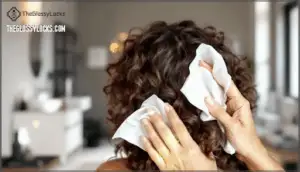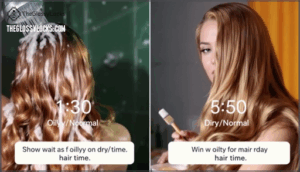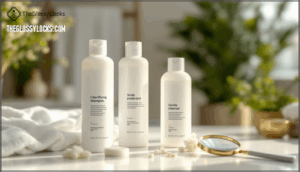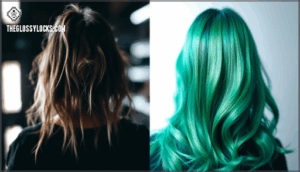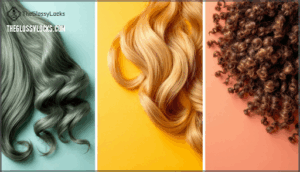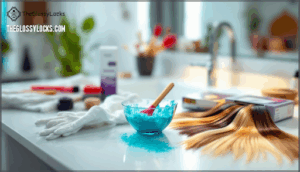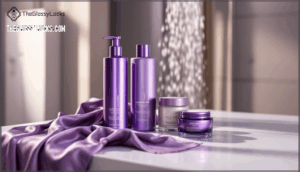This site is supported by our readers. We may earn a commission, at no cost to you, if you purchase through links.

Your hair’s natural oils create a protective barrier against harsh dye chemicals, but too much buildup can block pigment from penetrating the hair shaft.
The ideal balance depends on your hair type, the dye formula, and how your scalp usually behaves—and understanding these factors can mean the difference between salon-worthy results and a color catastrophe you’ll be fixing for months.
Table Of Contents
- Key Takeaways
- Should You Wash Your Hair Before Dyeing It?
- How to Prepare Hair for Coloring
- Does Hair Type Affect Pre-Dye Washing?
- Best Practices for At-Home Hair Dye Application
- Essential Post-Coloring Hair Care Tips
- Frequently Asked Questions (FAQs)
- Should you wash your hair before coloring?
- Can I dye my hair if I haven’t washed it in 3 days?
- How do I prepare my hair before coloring it?
- Can I apply hair dye on unwashed hair?
- Is it better to dye hair at home or go to a salon?
- How often should I dye my hair?
- Should I use a color-depositing shampoo or conditioner?
- Are there any natural alternatives to hair dye?
- Can you dye hair with styling products in it?
- Should you condition hair before applying dye?
- Conclusion
Key Takeaways
- Washing your hair 24-48 hours before dyeing creates the ideal balance—your scalp’s natural oils protect against irritation while keeping strands clean enough for even color absorption.
- Your hair type determines the perfect wash timing: oily hair needs washing a day before, while dry or normal hair benefits from waiting 48-72 hours to build up protective oils.
- Freshly washed hair lacks the natural oil barrier that prevents scalp sensitivity, which can lead to irritation and uneven dye results, despite what some people believe about "clean" hair being better.
- Heavy product buildup or excessive greasiness blocks dye penetration and causes patchy color, so skip styling products near your roots but don’t show up with completely clean hair either.
Should You Wash Your Hair Before Dyeing It?
You’ve probably heard conflicting advice about whether to wash your hair before dyeing it, and honestly, the answer isn’t one-size-fits-all. The truth depends on your hair type, the dye you’re using, and what your scalp needs to stay protected.
Let’s break down how washing impacts your results, what role natural oils play, and what the pros actually recommend.
How Washing Affects Dye Results
When you wash your hair right before dyeing, you’re actually stripping away the natural oils that act as a protective barrier between harsh chemicals and your scalp. This affects color absorption and pigment penetration, sometimes leading to uneven results or irritation.
The impact of washing hair before coloring varies by hair type, but preparing hair for coloring properly helps improve shade vibrancy and dye longevity through better chemical reactions.
The Role of Natural Oils
Think of your scalp’s natural oils as a built-in shield that softens the blow when dye chemicals show up to do their work. These oils create a natural barrier function that protects against irritation while still allowing proper dye absorption impact.
Your scalp’s natural oils act as a built-in shield, protecting against chemical irritation while still allowing proper color absorption
Your hair’s oil production balance matters—too much buildup can block color, while washing hair before coloring strips away the scalp oil benefits you need for comfortable, even results.
Expert and Professional Recommendations
So what do the pros actually say? Most leading salon brands recommend washing your hair 24 to 48 hours before you apply hair dye—it’s the ideal time for balancing scalp sensitivity with clean enough strands. Here’s the expert hair advice:
- 81% of professional colorists surveyed say skip the same-day shampoo to keep that protective oil layer intact
- Manufacturer guidelines from L’Oréal, Clairol, and Wella all agree: heavy product residue effects can mess with color, so aim for lightly dirty hair
- 97% of major U.S. salons tell clients not to show up with wet or freshly washed hair for coloring services
This helps preserve essential natural oils for healthier hair.
The takeaway? Hair washing before coloring works best when timed right—not squeaky clean, not overly greasy.
Common Myths Debunked
You’ve heard the old salon wisdom—but let’s separate fact from fiction. Here are the top debunking hair coloring myths:
| Myth | Reality |
|---|---|
| Dye always damages hair | Semi-permanent color can boost hydration by 25%; damage comes from bleach, not most dyes |
| Ammonia-free is gentler | Only 17% show less irritation; some substitutes swell hair cuticles 30% more |
| Dirty hair is better for dye | 78% of pros recommend washing 24-48 hours before; excess oil blocks even color absorption |
The bottom line? Modern formulas work best on balanced hair—not squeaky clean, not overly greasy.
Frequent coloring can, however, lead to dry and brittle hair, so consider safe options. Proper pre-coloring hair preparation and understanding the risks of dyeing greasy hair help you get salon-quality results. When washing hair before your next color session, aim for that ideal balance between fresh and oily.
How to Prepare Hair for Coloring
Getting your hair ready for color involves more than just deciding when to wash. You’ll need to check your hair type, time everything right, pick the proper products, and protect your strands from damage.
These four steps will help you achieve better, longer-lasting results.
Assessing Your Hair Type (Oily, Dry, Normal)
Before you color, you need to know your hair type—it makes a huge difference. Grab a tissue and press it to your scalp after a day without washing hair.
See oil? That’s oily hair. Nothing there? You’ve got dry hair. A light trace means normal hair. If some spots are oily while others aren’t, you have combination hair with different porosity levels and texture variations.
Timing Your Pre-Dye Wash
Once you know your hair type, the next step is figuring out exactly when to wash—and trust me, timing matters more than you’d think.
Oily hair? Wash the day before dyeing to minimize oil buildup without stripping your scalp bare.
Dry or normal hair? Wait 48 to 72 hours before your hair dye appointment—this gives your scalp enough natural protection while keeping hair clean enough for even color absorption.
Using The Right Pre-Color Products
The products you use before dyeing can make or break your color results—so let’s talk about what actually works. Here’s what smart pre-coloring hair preparation looks like:
- Clarifying shampoos remove heavy buildup (skip conditioner afterward—porosity equalizers work better)
- Scalp protectants create a barrier if you’re washing hair before dyeing within 12 hours
- Gentle cleansers maintain oil balance without stripping protection
Check product ingredients—sulfates and silicones interfere with hair dye application and color absorption.
Avoiding Damage Before Coloring
Your hair isn’t going to "grab" color well if it’s damaged—think of it like trying to paint a wall with cracks and holes.
Protect your scalp and hair by skipping hot tools for a few days before dyeing hair. Use pre-treatments to boost hair elasticity and balance porosity levels.
Remove product buildup with clarifying shampoo—this simple precoloring hair preparation step guarantees better color absorption and hair coloring safety.
Does Hair Type Affect Pre-Dye Washing?
Yes, your hair type plays a big role in when you should wash before dyeing. Oily, dry, and textured hair all need different timing to get the best color results.
Let’s break down what works for each type.
Oily Hair: When to Wash Before Dyeing
If your hair gets greasy by midday, you’re probably wondering whether that natural oil slick will help or hurt your dye job. Good news: oily hair actually works in your favor, but timing matters. Here’s what you need to know:
- Wash 24 hours before dyeing to balance scalp health and color absorption
- Skip clarifying shampoos that strip away protective oils
- Product residue won’t interfere with modern dye formulas
- Natural oils reduce scalp sensitivity during application
This timing protects against irritation while maximizing dye absorption rates and color longevity factors.
Dry Hair: Extending Wash Intervals
Dry hair craves a longer break between wash day and dye day—waiting 48 to 72 hours gives your scalp time to build up that protective oil barrier your hair desperately needs. This extended wash timing helps with damage prevention while supporting scalp hydration.
Your hair care regimen should focus on gentle product selection, avoiding harsh formulas that strip natural hair oil. This approach maintains scalp health and minimizes irritation during the coloring process.
Curly, Colored, and High-Porosity Hair Considerations
Curly hair brings unique challenges because of naturally higher hair porosity—up to 15% darker results than smoother textures. If you’ve got color-treated hair or high-porosity strands from past chemical processes, expect faster fading and uneven absorption.
Use porosity pre-treatment products and clarifying washes to balance curly absorption rates, prevent hair damage, and lock in hair moisture for vibrant, lasting color.
Best Practices for At-Home Hair Dye Application
You’ve got your dye ready, but success depends on how you apply it. The right setup, timing, and technique make all the difference between salon-worthy results and a patchy mess.
Let’s walk through the key steps to nail your at-home color job.
Preparing Your Workspace and Tools
Before you even think about mixing colors, setting up your workspace properly can mean the difference between a salon-worthy finish and a patchy disaster. Lay down towels or plastic sheeting, gather your mixing bowls and application brushes, and don’t skip protective gear like gloves and a cape.
Tool sterilization matters too—clean brushes give you better control during the at-home hair dyeing process. A proper dye station setup makes hair coloring techniques easier to execute.
Applying Dye to Washed Vs. Unwashed Hair
Once your tools are lined up and ready to go, the real question becomes whether to apply that dye to freshly scrubbed strands or hair that’s had a day or two to marinate in its own oils.
Unwashed hair gives you that protective oil barrier against scalp sensitivity, while clean hair can boost dye absorption and color vibrancy.
If you wash hair right before applying at-home hair dye, you risk more irritation but potentially brighter hair color—it’s a trade-off worth weighing.
Handling Roots, Lengths, and Ends
Roots grab color faster than lengths, and your ends—especially if they’re damaged or porous—can turn into a completely different shade if you’re not paying attention. Start at the roots, work dye down the hair shaft in small sections, and save those fragile ends for last.
Good sectioning techniques keep your color evenness on point and prevent the cuticle from absorbing too much pigment where you don’t want it.
Avoiding Common Application Mistakes
One wrong move—like skipping a strand test or piling on too much dye—can turn your dream color into a damage nightmare or a patchy mess. Here’s how to avoid the big ones:
- Always patch test 48 hours before to check for scalp irritation
- Section hair properly so every strand gets even coverage
- Mix dye to the right consistency—not too thick or runny
- Time your application carefully and don’t let dye sit too long
These steps protect your hair color and prevent unnecessary hair damage.
Essential Post-Coloring Hair Care Tips
You’ve put in the work to color your hair, and now it’s time to protect that fresh shade. The right aftercare routine makes all the difference between vibrant color that lasts and dye that fades fast.
Here’s what you need to know to keep your newly colored hair looking salon-fresh.
When to Wash Hair After Dyeing
After all that work choosing the perfect shade, the waiting game begins—and trust me, patience here is your new best friend. Wait at least 48 to 72 hours before shampooing after coloring—this gives pigments time to settle into your hair shaft for better color longevity.
Overwashing hinders pigment fixation, so check shampoo ingredients carefully—skip clarifying formulas initially.
| Time After Dyeing | Hair Care Action | Why It Matters |
|---|---|---|
| 0-24 hours | No shampooing or hair washing | Pigment settling begins; cuticles still open |
| 24-48 hours | Avoid heat styling and water exposure | Prevents premature color fade |
| 48-72 hours | First gentle wash with sulfate-free products | Minimizes color loss while cleansing |
| 72+ hours | Resume normal hair wash routine (with care) | Post-dyeing hair care tips kick in fully |
| Ongoing | Monitor touch-up frequency needs | Maintains vibrancy between salon visits |
Choosing Color-Protecting Shampoos and Conditioners
Your color investment deserves protection—sulfate-free shampoos and conditioners are your best defense. Look for products with UV filters and mild surfactants; these ingredients seal in pigment and prevent sun-related fading.
Here’s what matters most:
- Sulfate-free formulas minimize color stripping compared to traditional shampoos
- Silicone-based conditioners create a protective barrier that locks in dye molecules
- UV protection ingredients shield your hair from environmental color damage
Professional colorists recommend pairing color-protecting shampoo with matching conditioner—lab tests show this combo considerably improves retention after multiple washes.
Preventing Color Fading and Damage
The real color killer isn’t time—it’s heat, harsh water, and skipping a few simple protection habits. Limit hot tools, rinse with cool water to seal cuticles, and use UV protection sprays when you’re outdoors.
Weekly protein treatments strengthen strands, and gentle products prevent over-processing—small steps that make your hair color last longer without damage.
Recommended Products for Color Longevity
Good products don’t just protect your color—they actively strengthen it, lock in vibrancy, and prevent the slow fade that happens every time you wash. Here’s what keeps your color looking fresh:
- Sulfate-free shampoos and color-protecting conditioners maintain your shade without stripping
- UV protection sprays shield hair from sun damage and fading
- Hydrating masks and leave-in treatments restore moisture between color sessions
- Color boosters refresh tones and extend time between salon visits
Heat Styling and Hair Masks for Colored Hair
Heat styling and colored hair? That combo can be tricky—like trying to keep ice cream from melting on a summer day. Heat protectants are your best friend here—they shield color-treated hair from damage and color fading. Deep conditioning masks with ingredients like keratin and argan oil help with damage repair between styling sessions.
Limit your styling frequency to 2-3 times weekly when possible.
| Styling Practice | Impact on Hair Color |
|---|---|
| Daily flat ironing without heat protectant | Rapid fading, severe damage |
| Weekly heat styling with proper protection | Minimal color loss, manageable |
| Air-drying with occasional heat | Best color retention |
| Monthly deep conditioning mask | Vibrant, healthy appearance |
| Using styling products with UV filters | Extended color longevity |
Frequently Asked Questions (FAQs)
Should you wash your hair before coloring?
You don’t need wet hair for dye adhesion—but timing your hair washing frequency matters.
Natural scalp oils protect against sensitivity and help with product buildup, while hair porosity affects how color takes. Wait 24-72 hours before dyeing.
Can I dye my hair if I haven’t washed it in 3 days?
Yes, three-day-old hair is actually ideal for most at-home hair dye. Scalp oil buildup provides natural protection without affecting dye absorption rate or color result impact, making it perfect timing for coloring.
How do I prepare my hair before coloring it?
Preparing your hair for coloring is like prepping a canvas before painting—you want the surface just right. Start by evaluating your hair type and porosity levels to determine your wash timing. Skip washing 24-72 hours before to let protective oil buildup form on your scalp.
Schedule a hair color consultation for individual advice on scalp health and coloring needs. Always perform patch testing, avoid heavy product application near roots, and confirm your scalp protection is ideal before bleaching hair preparation or any chemical service.
Can I apply hair dye on unwashed hair?
Absolutely, you can dye unwashed hair—in fact, it’s often the better choice. Natural oils protect your scalp from irritation while helping the hair dye adhere properly.
Just avoid heavy product buildup or excessive greasiness, which can affect color results.
Is it better to dye hair at home or go to a salon?
Imagine this: your friend just saved $150 doing her own balayage at home, but now it’s patchy orange instead of sun-kissed blonde. That’s the risk-reward dance of DIY versus salon hair color.
Salon appointments offer expert color matching and application techniques, but at-home hair dye costs much less—usually $8-20 versus $50-300 for professional hair color service. Your hair stylist brings training and can fix mistakes on the spot, while DIY requires confidence and accepts higher potential risks like uneven coverage or unwanted tones.
How often should I dye my hair?
How often you dye depends on your hair’s natural growth rate and the type of color you choose. Root touch-ups usually happen every four to six weeks, while full hair color maintenance can stretch eight to twelve weeks if you’re focusing on hair health and minimizing damage assessment.
Should I use a color-depositing shampoo or conditioner?
Think of color-depositing products as your weekly touch-up artists. After dyeing, use a color-depositing shampoo or color-protecting conditioner to maintain hair color vibrancy and boost tone.
Apply weekly for a tone boost while preserving hair health through proper product selection.
Are there any natural alternatives to hair dye?
Plant-based dyes like henna coloring, vegetable pigments, coffee rinse, and beetroot dye offer gentler hair color options. They won’t match chemical hair dye results, but they’re kinder to your hair care routine and scalp.
Can you dye hair with styling products in it?
Styling products can create a barrier on your hair shaft. That’s not ideal when you’re trying to dye it.
Heavy product buildup blocks proper dye absorption, leading to patchy, uneven coloring that won’t last as long as it should.
Should you condition hair before applying dye?
Skip the conditioner right before dyeing—it creates a barrier on the hair shaft that blocks dye absorption. Your color won’t penetrate evenly, leading to patchy, faded results that nobody wants.
Conclusion
Here’s the truth: whether you should wash your hair before dyeing it isn’t a gamble—it’s a calculation. Your hair type, the dye formula, and your scalp’s oil production all determine the right move.
Skip the shampoo for 24-48 hours if you’re using permanent color, or wash if you’re fighting buildup that blocks pigment. Trust the science, not the myths.
Master these basics, and you’ll stop second-guessing every dye day. Your best color starts with knowing your hair’s needs, not following blanket rules.
- https://www.styleseat.com/blog/should-i-wash-my-hair-before-dyeing-it/
- https://us.wella.professionalstore.com/en-US/blog/haircare/should-you-wash-hair-before-coloring
- https://www.madison-reed.com/blog/should-you-wash-your-hair-before-coloring-it
- https://radicousa.com/blogs/stories/8-reasons-natural-dyes-dont-dye
- https://www.marieclaire.com/beauty/washing-hair-before-coloring/

